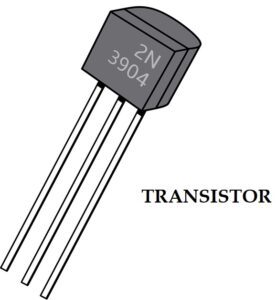What is transistor in electronics ? Transistor is an electronic device which transfer the signal from low resistance region to high resistance region.

For what is the filter circuit? click here
A transistor is a semiconductor device which has two junction, three layer and three terminals. The three terminals are Emitter, Base, and Collector. It is use for amplification.
There are two types of transistors (1) BJT (Bipolar junction transistor) and (2) FET ( Field effect transistor ). The BJT is of two types one is (1) n-p-n transistor and another is (2) p-n-p transistor.
n-p-n transistor is compose of two n-type semiconductors separate by a thin section of p-type. p-n-p transistor is formed by two p-type semiconductor separate by a thin section of n-type.
Amount of two junction one junction is forward bias and other is reverse bias. The forward bias junction has low resistance path whereas a reverse bias junction has high resistance path.
The weak signal is introduce in the low resistance circuit and output is take from the high resistance circuit. Therefore, a transistor transfers a signal from low resistance region to high resistance region.
npn and pnp transistor symbol

Read also this types of electron emission
Now we will learn about the three terminals ; So let’s start
Emitter
The emitter emits or supplies charge carriers for p-type supply hole charge carriers and in n-type its supply free electrons. The emitter is always forward bias with respect to base. It is heavily doped and its area less than the area of collector.
Base
The middle section which forms to p-n junction between emitter and collector is know as base. So it is lightly doped and it has narrow area.
Collector
The collector section collects the charge carriers there are emitted by the emitter. It is moderately doped and it has larger area. It is always reverse bias with the base.
So that it can remove charge carriers from its junction with the base.
For What is rectifier in electronics? click here.
Explain working of n-p-n transistor

In a n-p-n transistor the emitter base junction is forward bias and collector, base junction is reverse bias. The forward bias cause the free electrons very thin.
Therefore only a few electrons ( less than 5 % ) combine with holes to constitute base current ( IB ). The remaining free electrons (more than 95 % ) cross over into the collector region to constitute collector current ( IC ).
So in this way all most the entire emitter current flows in the collector circuit. In general the current equation is IE = IB + IC .
p-n-p transistor working

In a p-n-p transistor the emitter base junction is forward bias and collector base junction is reverse bias. The emitter is of p-type material which is heavily dope.
When the emitter is make forward bias with respect to base the holes from the emitter close towards the base. So this constitute the emitter current ( IE ).
As the base is lightly dope only 5% of holes recombine with the electrons present in the bases the rest 95% of holes travel towards the collector. And this constitute the collector current ( IC ). So in general the current equation is IE = IB + IC .
In this post we study about transistor and also we read the working of NPN, PNP and you will also get to know about various terminals in this post, I hope you like this article, Thank you.
